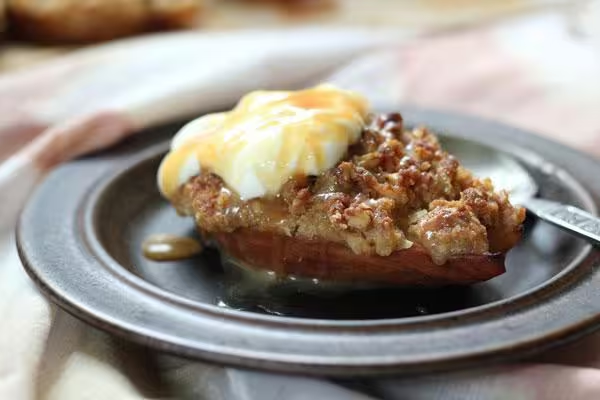
Caitlin Frame’s Easy Homemade Yoghurt
Season 7 Episode 6 | 5m 38sVideo has Closed Captions
Uncover the secret to exquisite, homemade yoghurt.
Uncover the secret to exquisite, homemade yoghurt.
Problems playing video? | Closed Captioning Feedback
Problems playing video? | Closed Captioning Feedback

Caitlin Frame’s Easy Homemade Yoghurt
Season 7 Episode 6 | 5m 38sVideo has Closed Captions
Uncover the secret to exquisite, homemade yoghurt.
Problems playing video? | Closed Captioning Feedback
How to Watch Kitchen Vignettes
Kitchen Vignettes is available to stream on pbs.org and the free PBS App, available on iPhone, Apple TV, Android TV, Android smartphones, Amazon Fire TV, Amazon Fire Tablet, Roku, Samsung Smart TV, and Vizio.

Get More Kitchen Vignettes
Get more recipes on the Kitchen Vignettes blog. Available on PBS Food.Providing Support for PBS.org
Learn Moreabout PBS online sponsorship- My name is Caitlin Frame.
My partner, Andy Smith, and I run the Milkhouse Farm and Creamery in Monmouth, Maine.
The Milkhouse is a certified organic, dairy farm and creamery.
The creamery is on site here.
It's a state licensed creamery At the Milkhouse, we make yogurt.
Primarily, that's the product that we're really pushing out into the world, the world being Maine.
Then we also bottle some raw milk and we also make eggnog around the winter holidays.
Our cows are mostly Jersey cows.
They're grazing six or seven months out of the year, basically 24/7 and then in the winter they're eating forage that we harvested during the summer off of our fields here.
Cows get milked twice a day every day.
They really just need a human to open the gate and they know where to go.
They walk themselves into the barn.
(uplifting country music) In our parlor the cows go in 10 at a time and get milked in there and then leave.
And they're right back out to the pasture to graze until the next milking.
(light uplifting music) Cows are really meant to eat grass.
They have a series of four stomachs that they evolved to digest grass.
And the nutrients that they're getting from that grass are gonna be passed along into their milk and that, you know, is gonna make for this really rich, nutritious milk.
Organic milk definitely has a nutrient profile that is very different and arguably better than conventional milk.
We are farming without pesticides and herbicides.
We are going for a lesser impact on human health, environmental health and trying to farm in a way that allows other ecosystems to thrive.
Today, we're gonna make a small batch of yogurt in our home kitchen.
I think people feel daunted by making yogurt at home but it's pretty simple.
We're gonna start with a gallon of milk.
We're gonna heat it up on the stove.
We're gonna check it and stir it just so it doesn't start sticking on the bottom.
And we're gonna bring the temperature up to 180 degrees.
And then we're gonna fill our kitchen sink with cold water.
And we're gonna put the hot pot of milk in the sink and water bath it and stir until the temperature comes down to between 115 and 110 degrees.
And then we're gonna add four tablespoons of yogurt to our milk.
And the yogurt that we wanna use needs to be made with live bacterial culture.
We wanna make sure it's evenly distributed.
After we've stirred in the culture, you can either incubate your whole pot of milk or you can pour that cultured milk into jars.
You take a small cooler and you're gonna wanna fill that cooler maybe four inches with warm water that is between 110 and 115 degrees.
to help keep the temperature regulated.
You're gonna put your pot in or your jars and you're gonna let that incubate for five to eight hours.
After that, you're gonna want the milk to look solid.
If it's not, if it's still really runny, then put it back in and let it incubate for another hour or so.
My family eats a lot of yogurt.
It is what we call our fast food.
It's just really easy and quick to have as a snack.
We have yogurt bowls with granola, fruit, maple syrup.
We use yogurt in smoothies.
We use yogurt as a condiment.
Yogurt is so, so versatile.
How yogurt tastes is a direct reflection of the milk that's used to make it as well as the different strains of cultures.
If you're trying to make your own yogurt, use the yogurt that you like to eat at home and your yogurt that you make will taste similar to that.
- Maybe we're gonna have to eat all that yogurt that we made today.
- Yeah, we can't sell that.
It wasn't made in the creamery so that's an illegal commodity.
(soft piano music) - [Caitlin] We started out making very small batches of yogurt and in the last 10 years we've grown a lot.
And now we have a much wider reach within the state of Maine that includes yogurt being sold in grocery stores, natural food stores and also Hannaford.
And then in the past three or four years, we've really expanded selling yogurt to schools as well.
And that was a really meaningful move for us to know that we were feeding a lot of kids.
And kids were able to access that food regardless of their income level.
Knowing that what happens here and what we do along with our employees is shared and partaken in by so many people in Maine is a really meaningful thing to us and our family.
(soft piano music)


- Food
Lidia Celebrates America
Lidia Bastianich honors America’s volunteers, revealing how giving back unites and uplifts.












Support for PBS provided by:
